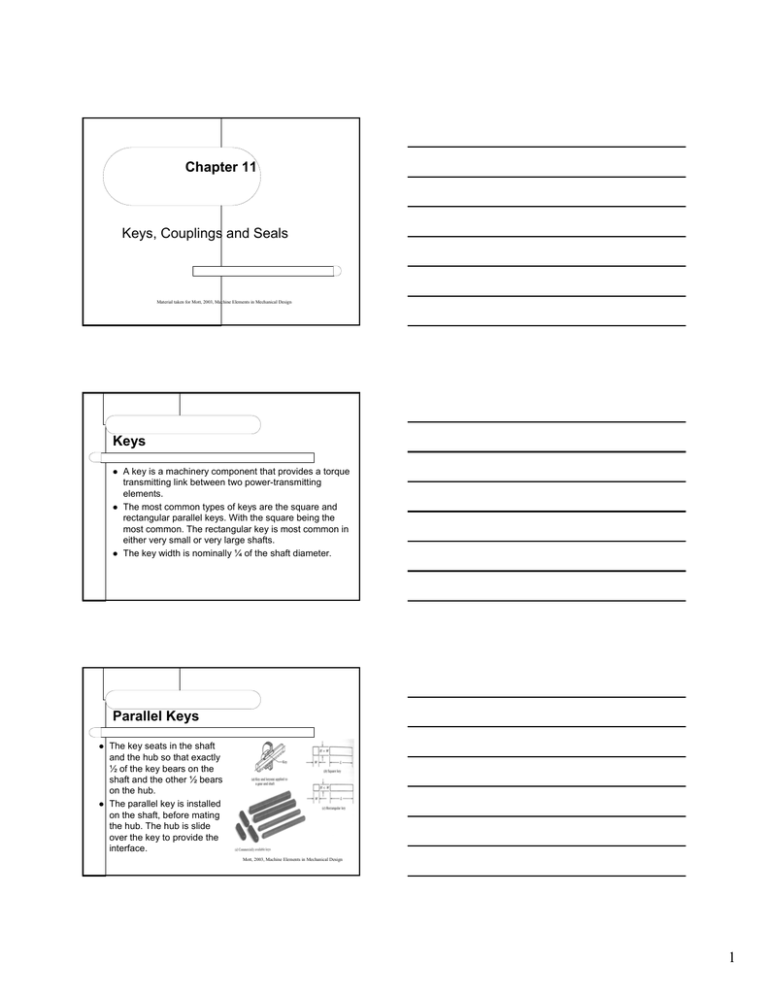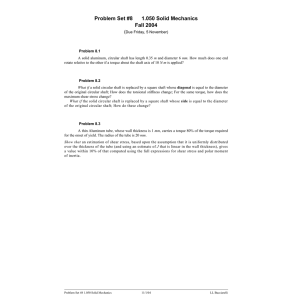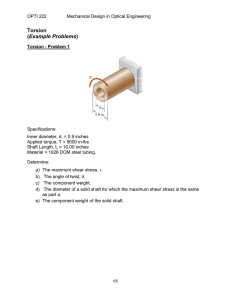Chapter 11 Keys, Couplings and Seals Keys Parallel Keys
advertisement

Chapter 11 Keys, Couplings and Seals Material taken for Mott, 2003, Machine Elements in Mechanical Design Keys z z z A key is a machinery component that provides a torque transmitting link between two power-transmitting elements. The most common types of keys are the square and rectangular parallel keys. With the square being the most common. The rectangular key is most common in either very small or very large shafts. The key width is nominally ¼ of the shaft diameter. Parallel Keys z z The key seats in the shaft and the hub so that exactly ½ of the key bears on the shaft and the other ½ bears on the hub. The parallel key is installed on the shaft, before mating the hub. The hub is slide over the key to provide the interface. Mott, 2003, Machine Elements in Mechanical Design 1 Key Shaft vs. Shaft Diameter Mott, 2003, Machine Elements in Mechanical Design Dimensions for Fabrication z z Keys are usually cut with a end-mill or circular-mill cutters and leave square corners which create stress concentrations. Radiused keyseats and chamfered keys can reduce stress concentrations. Mott, 2003, Machine Elements in Mechanical Design Key Types z z Tapered keys are installed after mating the hub and shaft. The taper extends over the length of the hub. Pin keys reduce stress concentration, but requires a tight fit. Mott, 2003, Machine Elements in Mechanical Design 2 Woodruff Keys Mott, 2003, Machine Elements in Mechanical Design Used in light loading applications, where it is desirable to easy assembly and dis-assembly. z Selection of Key z z The type and size of the key is usually selected after the shaft and hub have been designed. The length and material specification is determined through by design analysis, while two factors limit their selection: – – z z Width of the hub Distance to adjacent stress concentrations. Key is held in place by; set screws, shoulders, retaining rings, or spacers. Keys are commonly made of low-carbon, cold-drawn steel; such as AISI 1020CD with 61 ksi, ultimate strength. Stress Analysis z There are two basic failure modes for keys transmitting power. – – Shear across the shaft/hub interface Compression failure due to bearing stress between key and shaft, or hub. 3 Shear Stress Analysis Mott, 2003, Machine Elements in Mechanical Design z z The torque in the shaft creates a force on the lower left side of the key which in turn creates a reaction force on the upper right side of the key, transmitting the torque into the hub. This force couple places the key in shear over the surface A = W*L, where F = T / (D/2) Shear Stress Analysis z Shearing stress τ= F A s z Design stress z Key Length τ d = T 2T = ( D / 2)(WL) DWL = 0.5 s y / N L= τ 2T DW d Bearing Stress Analysis z z Failure in bearing is due to compressive stress that acts of shaft or hub area: L * (H/2), where failure occurs on the surface with the lowest compressive yield strength. Design Stress σ z d = sy / N N = 3 is typical 4 Bearing Stress Analysis, cont. z Actual compressive stress σ= F A c z 4T T = ( D / 2)( L)( H / 2) DLH Solving of required length using design stress L= z = 4TN 4T = DW s y σ d DH Using Sy from material of lesser yield compressive strength, be it the key, shaft or hub. Parallel-Square Key Design z z z z z z Complete shaft design and spec. shaft diameter. Select key size, using W=H if shaft size < 6.5”. Spec. material, usually AISI 1020 CD Determine yield strength of key, shaft and hub. Check design based on shear stresses in key, and bearing stresses on material with lesser compressive yield strength. Complete design details of keyseat and key for fabrication. Mott, 2003, Machine Elements in Mechanical Design 5 Example Splines z z A spline can be described as a series of axial keys machined into a shaft, with corresponding grooves machined into the bore of the mating part (gear, sheave, sprocket, etc). The splines perform the same function as a key in transmitting torque from the shaft to the mating element. Splines con’t z There are many advantages of splines over keys. – z z Because 4 or more splines are used, as compared with 1 or 2 keys, a more uniform transfer of torque and a lower loading on a given part of the shaft/hub interface result. The splines are integral with the shaft, so no relative motion can occur as between a key and the shaft. Because of the multiple splines on the shaft, the mating element can be indexed to various positions. 6 Splines con’t z z Splines can either be straight-sided or involute. The involute form is preferred because it provides for self-centering of the mating element and because it can be machined with standard hobs used to cut gears. Straight-Sided Splines z Straight splines are made according to the specifications of the SAE and usually contain 4, 6, 10, or 16 splines. Mott, 2003, Machine Elements in Mechanical Design Mott, 2003, Machine Elements in Mechanical Design 7 Straight-Sided Splines con’t z The torque capacity for SAE splines is based on the limit of 1000-psi bearing stress on the sides of the splines, from which this formula is derived: – – – – T = 1000NRh Where N = number of splines R = mean radius of the splines h = depth of the splines Straight-Sided Splines con’t z The torque capacity is per inch of length of the spline. 1 D d D+d R = [ + ]= 2 2 2 4 1 h = (D − d) 2 Straight-Sided Splines con’t z Then, T = 1000N z D2 − d 2 (D + d) (D − d) = 1000N 4 2 8 This equation can be further refined for each of the types of splines by substitution of the appropriate relationships for N and d. 8 Straight-Sided Splines con’t z z For example, for the 6-spline version and the B fit, N = 6, d = 0.850D, and d2 = 0.7225D2. Then, 2 2 T = 1000 * 6 z D − 0.7225D = 208D2 8 Therefore, the required diameter to transmit a given torque would be D = T / 208 Straight-Sided Splines con’t z z Use the same approach to find the torque capacities and required diameters for the other versions of straight splines. The next slide enables an acceptable diameter to be chosen for a spline to carry a given torque, depending on the desired fit, A, B, or C. Torque Capacity Per Inch of Spline Length Mott, 2003, Machine Elements in Mechanical Design 9 Torque Capacity for Straight Splines Mott, 2003, Machine Elements in Mechanical Design Involute Splines z z Involute splines typically made with pressure angles of 30o, 37.5o, or 45o. The major diameter fit produces accurate concentricity between the shaft and the mating element. Involute Splines, con’t z In the side fit, contact occurs only on the sides of the teeth, but the involute form tends to center the shaft in the mating splined hub. Mott, 2003, Machine Elements in Mechanical Design 10 Pinning z z z With the element in position on the shaft, a hole can be drilled through both the hub and the shaft, and a pin can be inserted in the hole. The straight, solid, cylindrical pin is subjected to shear over two cross sections. If there is a force, F, on each end of the pin at the shaft/hub interface, and if the shaft diameter is D, then: – T = 2F (D /2) = FD Pinning con’t Mott, 2003, Machine Elements in Mechanical Design Pinning con’t z With the symbol d representing the pin diameter, the shear stress in the pin is: τ= z F T 4T = = As D( πd 2 / 4) D( πd 2) Letting the shear stress equal the design stress in shear as before, d= 4T D( π)( τd ) 11 Pinning con’t z Sometimes the diameter of the pin is purposely made small to ensure that the pin will break if a moderate overload is encountered, in order to protect critical parts of a mechanism. z One problem with cylindrical pins is that fitting them adequately to provide precise location of the hub and to prevent the pin from falling out is difficult. – Such a pin is called a shear pin. Pinning con’t z The taper pin overcomes some of these problems, as does the split spring pin. Mott, 2003, Machine Elements in Mechanical Design Keyless Hub to Shaft Connections z z Using a steel ring compressed tightly around a smooth shaft allows torque to be transmitted between the hub of a power-transmitting element and a shaft without having a key between the tow elements. The Locking AssemblyTM employees steel rings with opposing mating tapers held together with a series of fasteners. 12 Locking Assemblies Mott, 2003, Machine Elements in Mechanical Design Keyless Hub to Shaft Connections z With the Locking AssemblyTM placed completely within a counter bore of the hub of virtually any kind of power-transmitting element such as a gear, sprocket, fan wheel, cam, coupling, or turbine rotor, the fasteners can be tightened to achieve an excellent torque carrying interface. Split Taper Bushing z z z A split taper bushing uses a key to transmit torque. Axial location on the shaft is provided by the clamping action of a split bushing having a small taper on its outer surface. When the bushing is pulled into a mating hub with a set of cap screws, the bushing is brought into tight contact with the shaft to hold the assembly in the proper axial position. 13 Split Taper Bushing Mott, 2003, Machine Elements in Mechanical Design Set Screws z z z A set screw is a threaded fastener driven radially through a hub to bear on the outer surface of a shaft. The point of the set screw is flat, oval, coneshaped, cupped, or any of several proprietary forms. The point bears on the shaft or digs slightly into its surface. Set Screws Mott, 2003, Machine Elements in Mechanical Design 14 Set Screws con’t z z The set screw transmits torque by the friction between the point and the shaft or by the resistance of the material in shear. The capacity for torque transmission is somewhat variable, depending on the hardness of the shaft material and the clamping force created when the screw is installed. Mott, 2003, Machine Elements in Mechanical Design Couplings z z The term coupling refers to a device used to connect two shafts together at their ends for the purpose of transmitting power. There are two general types of couplings: rigid and flexible. 15 Rigid Couplings z z z Rigid couplings are designed to draw two shafts together tightly so that no relative motion can occur between them. This design is desirable for certain kinds of equipment in which precise alignment of two shafts is required and can be provided. In such cases, the coupling must be designed to be capable of transmitting the torque in the shafts. Rigid Couplings con’t z The load path is from the driving shaft to its flange, through the bolts, into the mating flange, and out to the driven shaft. The torque places the bolts in shear. Mott, 2003, Machine Elements in Mechanical Design Rigid Couplings con’t z The total shear force on the bolts depends on the radius of the bolt circle, Dbc / 2, and the torque, T. z Letting N be the number of bolts, the shear stress in each bolt is: – F = T / (Dbc / 2) = 2T / Dbc τ = F F 2T = = A s N (π d 2 / 4 ) D bc N (π d 2 / 4 ) 16 Rigid Couplings con’t z Letting the stress be equal the design stress in shear and solving for the bolt diameter: d= 8T DbcN( πτd ) Rigid Couplings con’t z z Rigid couplings should be used only when the alignment of the two shafts can be maintained very accurately, not only at the time of installation but also during operation of the machines. If significant angular, radial, or axial misalignment occurs, stresses that are difficult to predict and that may lead to early failure due to fatigue will be induced in the shafts. Flexible Couplings z z z Flexible couplings are designed to transmit torque smoothly while permitting some axial, radial, and angular misalignment. The flexibility is such that when misalignment does occur, parts of the coupling move with little or no resistance. Thus, no significant axial or bending stresses are developed in the shaft. 17 Mott, 2003, Machine Elements in Mechanical Design Mott, 2003, Machine Elements in Mechanical Design Mott, 2003, Machine Elements in Mechanical Design 18 Mott, 2003, Machine Elements in Mechanical Design Universal Joints z z When an application calls for accommodating misalignment between mating shafts that is greater than the 3 degrees typically provided by flexible couplings, a universal joint is used. Angular misalignments of up to 45o are possible at low rotational speeds with single universal joints like the one shown on the next slide, consisting of two yokes, a center bearing block, and two pins that pass through the block at right angles. Universal Joints con’t z z Approximately 20 to 30 degrees is more reasonable for speeds about 10 rpm. Since universal joints have the disadvantage that the rotational speed of the output shaft is nonuniform in relation to the input shaft. Mott, 2003, Machine Elements in Mechanical Design 19 Universal Joints con’t z z z z z z A double universal joint allows the connected shafts to be parallel and offset by large amounts. Furthermore, the second joint cancels the nonuniform oscillation of the first joint so the input and the output rotate at the same speed. This figure shows a vehicular universal joint used for connecting an engine or transmission to the drive wheels used in some rearwheel drive cars, light and heavy trucks, agricultural equipment, and construction vehicles. The spider assembly contains needle-bearing rollers on each arm. The right end shows a ball stud yoke, a flange yoke, and a center coupling yoke that make up a double Cardan universal joint. Another style, called a constant velocity joint, or CV joint, is often used as a key component of front wheel drive and all wheel drive vehicle drivelines. Mott, 2003, Machine Elements in Mechanical Design 20



